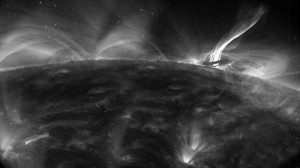Space Out at the Hirshhorn’s Friday Night “After Hours” Party With Semiconductor
/https://tf-cmsv2-smithsonianmag-media.s3.amazonaws.com/filer/20110520110632image_1_689-300x200.jpg)
Kick off your Halloween weekend the right way: the After Hours way. This Friday night at the Hirshhorn, Ruth Jarman and Joe Gerhardt, the multi-media artist duo known as Semiconductor, will be screening three of their experimental films. They’re trippy, spacey, and free-flowing cinema. Which makes them perfect for Halloween, or as visuals for a Pink Floyd concert.
There’s an astrological theme running through all three of their pieces. On both Brilliant Noise and Black Rain, Semiconductor utilized open access archives, like NASA, to create old-fashioned monster movies of raw, grainy, unpolished satellite footage of the sun and space, respectively. And Heliocentric is Semiconductor’s technicolor effort–a hazy, time-lapse shot of the sun across Earthen landscapes.
But before you order your advance tickets (the only way to go, baby!) for "After Hours" so you can get your drink on with DJs Matt Bailer and Robert Bozick while you watch the heavens move and wander among some gorgeous art, check out the email interview with current Smithsonian fellows Semiconductor below:
I hear you’re doing a fellowship at the Smithsonian, researching your current project on volcanoes at the National Museum of Natural History. What’s it about?
We are based in the Department of Mineral Sciences within the Smithsonian Museum of Natural History for three months as part of a Smithsonian Artists fellowship researching the science of the origin of the solid Earth in the form of volcanoes, rocks and minerals. We are exploring the types of matter and processes the scientists are concerned with and reflecting on how this field of science does or can inform our day-to-day experience of the physical universe, looking for a tangible relationship that can be related to on a human scale, whether it’s the way we experience time, physical scales or matter, and reflect on man’s place in the larger universe. We spend every day in the lab, whether it's observing the scientists at work, collecting material to become part of new works, or interviewing them to explore their sciences with them.
You seem to come from a scientific, as well as a cinematic, background. Whom do you consider to be your largest influences?
We started off working together making music and sound as live performances where we formed the name Semiconductor. But really we were visual artists in disguise, and it wasn't long until we started reintroducing imagery with our music, and the best way to describe this was as moving image or cinema. This created a strong link between sound and image that went far beyond choreography and closer to synesthesia. It was here that our understanding of the links between light and sound started to merge with science, as we explored all the ways they crossed paths.

Science and cinema–perfect together?
The phenomena of projected light and sound has been developed by both science and art over the years and each dependent on the other. We take from both worlds, but there are many obstacles that we are learning to navigate where objectivity and subjectivity clash.
What are your feelings on the recent 3D movie trend? Is bigger and fancier better?
The current trend in 3D is a bit of the future that got lost in the past somewhere back in the 1950s. Really, the future of cinema is in fully immersive environments, and that's already happening in computer games.
I was watching your short film Magnetic Movie, which is interesting, but also visually stunning. Did you ever consider working in other mediums, like music videos?
We have made a few music videos over the years most notably for an Icelandic band called múm. Our work is generally too time consuming for us to make music videos, but there's further problems where we become subservient to the music and musicians, and visual artists should be seen as important on equal terms.
After viewing one of your films, what do you want the audience to leave thinking?
We hope to leave both conscious and subliminal marks on our viewers, where the way you see the world changes slightly. We also often try to create a sense of timelessness in our artworks that helps keep them alive.
/https://tf-cmsv2-smithsonianmag-media.s3.amazonaws.com/accounts/headshot/Jeff-Campagna-240.jpg)
/https://tf-cmsv2-smithsonianmag-media.s3.amazonaws.com/accounts/headshot/Jeff-Campagna-240.jpg)